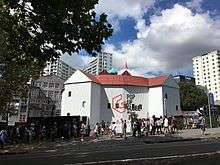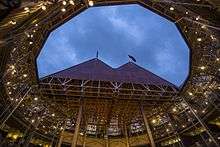Pop-up Globe

Pop-up Globe (PUG) is a theatre production company, based in Auckland, New Zealand, dedicated to producing the works of William Shakespeare. The company’s theatre is the world's first full-scale, temporary pop-up reconstruction of the Second Globe Theatre (1614-44). The theatre’s first venue was in Auckland CBD, next to the Auckland Town Hall, from February-May 2016; PUG’s second season will open on 23 February 2017 at Ellerslie Racecourse in Auckland.[1]
Background
Pop-up Globe was founded in 2015 by Artistic Director Dr Miles Gregory. Commercial Director Tobias Grant joined the project at a very early stage. Both are both native Aucklanders. Gregory had worked for 18 years in the UK as a director and producer,[2] and Grant had a background in media and marketing.
The first season, featuring the Pop-up Globe Theatre Company performing Twelfth Night and Romeo and Juliet, with independent visiting productions of Titus Andronicus, The Tempest, Much Ado About Nothing, Henry V, Antony and Cleopatra and Hamlet, opened on 18 February 2016, as part of the commemorations of the quatercentenary of Shakespeare’s death.[3] Over 100,000 tickets were sold during a 12-week season,[4] making it the largest Shakespeare festival in the Southern Hemisphere.
The second season will feature two in-house repertory acting companies, Queen’s and King’s, performing Much Ado About Nothing/Othello and As You Like It/Henry V respectively.[5]
Theatre

The theatre’s architectural plan is based on the published research of Professor Tim Fitzpatrick of Sydney University.[6] It is a 16-sided polygon, 88 feet in external diameter. This is some 12 feet smaller than Shakespeare’s Globe in London, which some scholars and theatre practitioners have judged to be too large.[7][8] Fitzpatrick’s reconstruction synthesises a mathematical projection based on Wenceslaus Hollar’s Long View of London from Bankside sketch of London’s skyline in the early 1640s with extensive research into the Jacobean ad quadratum technique of architectural planning, and with the results of the limited archaeological evidence available from the site of the original Globe.
The theatre is 56 feet high, with a standing capacity of 300 'groundlings' and 600 seats in three galleries. It is topped by a distinctive ‘onion dome’, visible in the Hollar sketch. The theatre is constructed by Camelspace, a New Zealand construction company specialising in scaffolding structures.
The interior design of the stage (43 feet in width, as specified in the contract for the Fortune Playhouse) has changed significantly between the first and second seasons. The first season employed a canted scaenae frons across four audience bays at the rear of the stage, with four doors in a neo-classical design. The audience was seated in 360°, with “Lord’s” and “Gentlemen’s” rooms in the middle and upper galleries behind the stage. The 2017 season will feature a flat scaenae frons with three doors in a baroque design, with the audience seated around 270°, with a balcony above the central door, and a musician’s gallery above the balcony.
References
- ↑ "Pop-up Globe to rise in the gardens at Ellerslie Racecourse". stuff.co.nz. Retrieved 21 November 2016.
- ↑ Gregory, Miles. "Guest Blog: Why I want to build a pop-up Globe Theatre". whatsonstage.com. Retrieved 21 November 2016.
- ↑ Van Beynen, Jack. "Shakespeare's death remembered at the Pop-up Globe theatre". stuff.co.nz. Retrieved 21 November 2016.
- ↑ Awde, Nick. "New Zealand's Pop-up Globe". The Stage. Retrieved 21 November 2016.
- ↑ "Pop-up Globe Theatre to rise again - at Ellerslie Racecourse". nzherald.co.nz. Retrieved 21 November 2016.
- ↑ Fitzpatrick, Tim. "Reconstructing Shakespeare's second Globe using 'Computer Aided Design' (CAD) tools". extra.shu.ac.uk/emls/si-13/fitzpatrick/. Sheffield Hallam University. Retrieved 21 November 2016.
- ↑ Egan, Gabriel. "The 1599 Globe and its modern replica: Virtual Reality modelling of the archaeological and pictorial evidence". Early Modern Literary Studies. Sheffield Hallam University. Retrieved 21 November 2016.
- ↑ Egan, Gabriel (2001). "Globe Theatre" in The Oxford Companion to Shakespeare (1st ed.). OUP. p. 166. ISBN 9780198708735. Retrieved 21 November 2016.